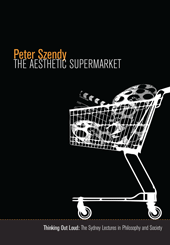- Members
- Research
- Undergraduate Studies
- Postgraduate Studies
-
Events
- - Encountering the Author
- - Sydney Seminar
- - Sponsored Conferences
- - Postgraduate Seminars
-
- Thinking Out Loud
- - 2019 Mufti Strangers in Europa
- - 2018 Rosi Braidotti “The Human in the Age of Technology and Climate Change"
- - 2016 Thomas Keenan "Claiming Human Rights"
- - 2015 David Wood "Responsibility in the Age of Climate Change"
- - 2014 Szendy, "The Aesthetic Supermarket"
- - 2013 Bonnie Honig, "Public Things"
- - 2012 Gourgouris "Secular Criticism"
- Research Seminars
- Contact
2014 Peter Szendy, "The Aesthetic Supermarket"
These lectures will explore the hypothesis that aesthetics, that is, the field of the sensible, is a kind of market of senses and sensations, a properly sensational market.
Monday, May 5, 2014,
Download the first lecture (opens in a new window): "From the Department Store to the Shopping Mall: Cinema and its Markets". Download the response and Q&A (opens in a new window). Response by Christopher Peterson followed by discussion.
Wednesday, May 7, 2014,
Download the second lecture (opens in a new window): "The Value of images". Download the response and Q&A (opens in a new window). Response by Christopher Peterson followed by discussion.
Friday, May 9, 2014,
Download the third lecture (opens in a new window): "The Commodity Gaze". Download the response and Q&A (opens in a new window). Response by Christopher Peterson followed by discussion.

State Library of NSW, Metcalfe Auditorium 5.30 pm to 7.30 pm
$10 per lecture or $25 for entire series.
In examining the structure of this hyper- or super-market of the sensible, we will let ourselves be guided primarily by cinema. Were it necessary to justify this choice by a single image, we might invoke the opening sequence of Robert Bresson's L'Argent (1983). Even before the credits roll – literally opening the film – the door of an automatic teller closes by sliding from right to left. It is as if this closure were the condition for the film to begin, at once revealing and concealing the economies underlying each of the following frames (Bresson himself wrote, in his Notes on Cinematography, that there is "no absolute value in an image," that images accordingly have only an exchange value).
In this sense, L'Argent might be read as an allegory of the filmic image itself, insofar as it proceeds from an implicit market: a market that it simultaneously unveils and veils, in order to be the image that it is. Yet the economy that underlies images—what we will call, after Susan Buck-Morss, their iconomy—clearly draws on a history which long precedes that of cinema. This is why the films that will punctuate our analysis should lead us to re-examine the genealogy of nihilism as an unlimited generalisation of the logic of values. If value, as Heidegger wrote in European Nihilism, is always "posited by seeing" (vom Sehen gesetzt) in the form of a "point of view," what is ultimately at issue is quite simply the way that we see in an increasingly iconomic era of a capitalism.
The three lectures represent three ways of approaching this problematic.
Lecture 1: From the department store to the shopping mall: cinema and its markets
After considering the origins of cinema (contemporaneous with the arcades evoked by Walter Benjamin and the "moving walkways" that transported the visitors of the Paris World Fair in 1900), we will attempt to map places of exchange such as they are represented on the screen. We will pay special attention to the Marx Brothers' The Big Store (1941), we will follow the adventures of Bresson's Pickpocket (1959) who roams the metro and the train stations, we will jump into the supermarkets of The Big Lebowski (1998) and The Hurt Locker (2008), we will accompany the protestors of Godard's Tout va bien (1972) as they attack a Carrefour store. . . . Each time, it will be a matter of keeping an eye out for what Bresson called "the exchanges that are produced between images and images."
Lecture 2: The value of images
In a recent article ("In Defense of the Poor Image," e-flux journal, n° 10, novembre 2009), Hito Steyerl proposed to "redefine the value of the image": "Apart from resolution and exchange value, one might imagine another form" of value defined by velocity, intensity, and diffusion. Poor images are poor because they are heavily compressed and travel quickly." But the new value of poor images comes not only from their increased circulation, that is to say their frantic exchange. Paradoxically, images endowed with low resolution often acquire greater credibility as testimony, a documentary credit superior to that of HD images, which can always be suspected of having been tampered with. Brian De Palma's Redacted (2007) stages these questions in a virtuoso way. Since Benjamin proposed the distinction between the cult value and the exhibition value of images (in The Work of Art in the Age of Its Technological Reproducibility), what has happened in terms of faith and belief, what has happened to the fiduciary and to credit in the age of the iconomy?
A point of view, Nietzsche says in essence, is the position of a value. And Heidegger comments: "value becomes a 'point' that belongs to the purview opened by the envisioning of something," that is to say that it correlates to "a seeing that punctuates and reckons by means of 'points'" (European Nihilism). We can see this permanent evaluation making up the fabric or the material of our gaze at work in films like King Kong (1933) or its 2005 remake by Peter Jackson. But what it must force us to consider is not only the punctuating calculation that inhabits and animates our eyes: it is also our gaze as it becomes itself calculable and predictable, notably in the increasingly sophisticated techniques of eye-tracking, which appropriate our ocular movements by inscribing them in a veritable optical market governing the general circulation of images today. Video games, which have inspired a number of films (notably De Palma's 1998 film Snake Eyes) are probably one of the more active fields of this iconomic capitalism.
Mobile options:




